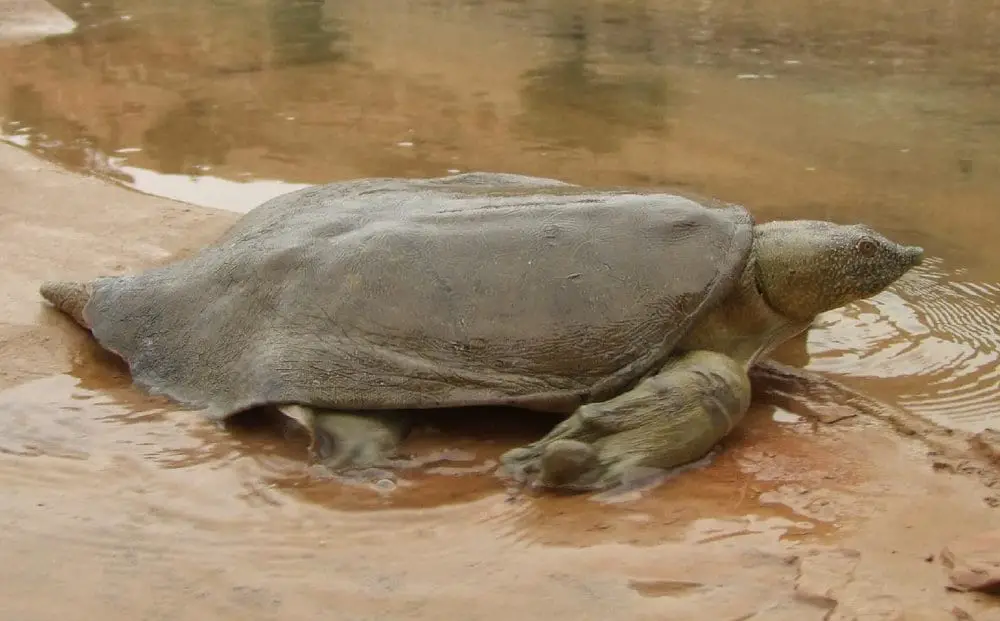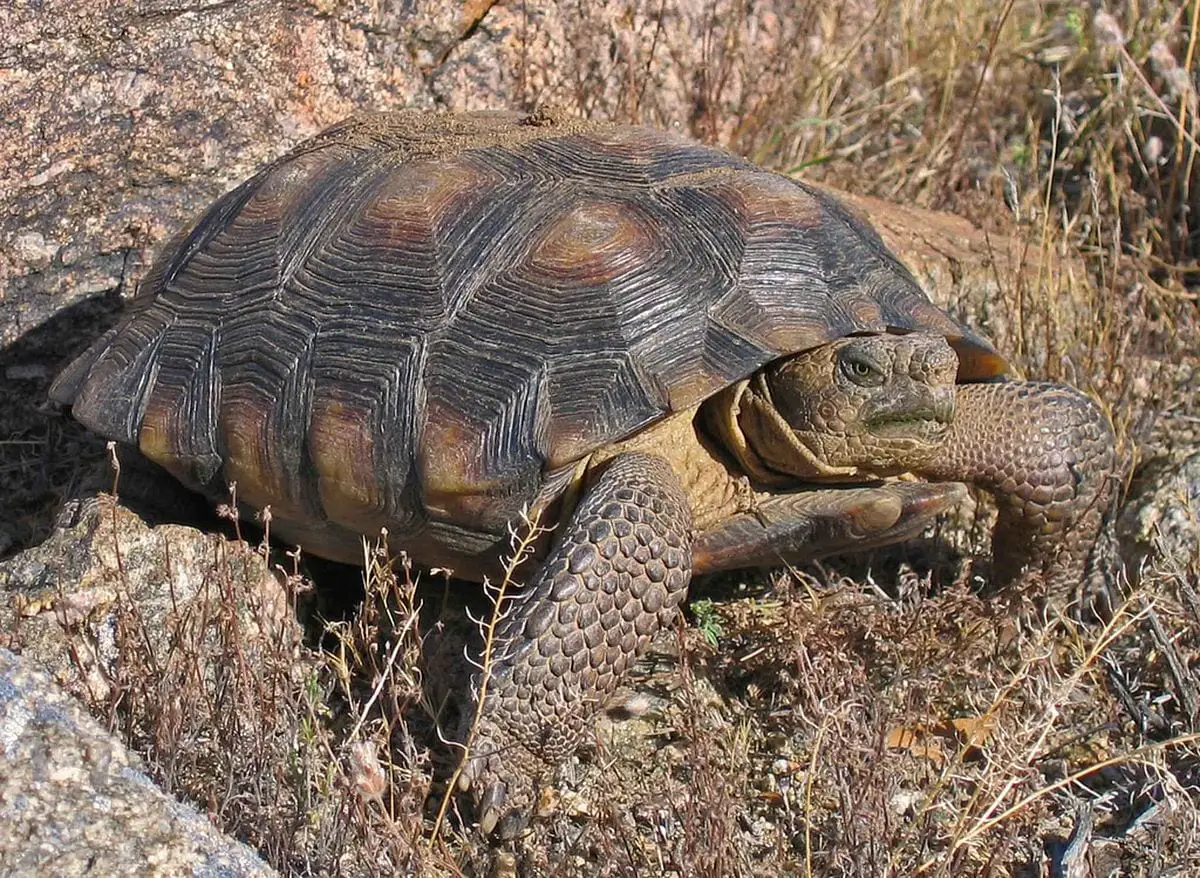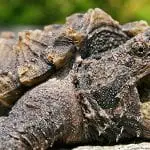Scientific Facts
| Common Name: | Sonoran Desert Tortoise |
| Scientific Name: | Gopherus morafkai |
| Life Span: | 45 to 50 (wild) 50 to 90 years (captivity) |
| Size: | 10 to 14 in. (adults) and 2 to 2 1/2 in. (hatchlings) |
| Habitat: | Semi-desert grassland, bajadas, mountains, boulders, hillsides, canyons, mountain tops |
| Country of Origin: | Sonoran, Colorado river to southeastern and south-central Arizona |
Physical Description
The Sonoran desert tortoise is a large and resilient terrestrial turtle that is mostly found in the Sonoran desert. It’s known for its keelless carapace that has a color range of gray to orange. Its form and shapes are rough compared to other turtles, and its plastron is not hinged. The turtle also has elephantine limbs with front feet that resembles just like a shovel – the digits are unwebbed. The median projection of these turtles also extends from the gular shield, which is the front plastron. Its shell can reach up to 15 inches or 380 mm. The dome-shaped and growth rings on the top part of its shell make them unique. Thus, growers all over the world are looking to rear this turtle.
Its coloration can vary from nearly black, gray, gray-brown, and even orange. Their underside plastron can vary from tan to yellow. The turtle has a short tail and thick armored large scales. Its head is small and more rounded compared to other turtles. It also has a narrower shell width and shorter gular shields. They can reach semi-desert grassland like the Santa Cruz river Valleys up to San Pedro River valley. It’s also natural to encounter these turtles in Chihuahuan deserts and Cochise County.
These turtles love mountainous and rugged terrain. You can find them in boulders and caves as well where they spend the night and escape from predators or bad weather conditions. They also love to dig their burrows or look for existing holes. The species is also capable of improving an existing shelter site. Although they are naturally desert mountain dwellers, for them to reproduce and connect with other tortoises, they move to low-density valleys. They do this to maintain genetic connectivity.
Lifespan
These turtles can live and thrive for about 50 to 90 years in captivity. However, in the wild, they can only live from 40 to 50 years. Causes of Sonoran desert tortoise mortality include disease, environment, predators, and human-related factors. Their predators are coyotes, badgers, kit foxes, ravens, fire ants, and Gila monsters. When taking care of them in captivity, you must provide them a clean and safe environment that is almost a replica in their natural habitat.
Eating Habits
The Sonoran desert tortoise is vegetarian. They eat a wide variety of plants, grasses, and succulents. They are also known for eating herbs and woody plants. These turtles grow healthily if they are fed with green herbaceous grasses and plants. Although they can also eat dried plants as well. It’s also typical to see these turtles eat fruits from the prickly pear cacti. Which is why you’ll see some of them have reddish stain or spots around their mouth. They live slowly, and they also die slowly. To keep them active and healthy throughout their lives, you must feed them the real meals.
They are turtles that can eat almost anything that you feed them. That’s why even beginners can rear them without any difficulty. However, it’s also important to note that even if the food is unhealthy for them, they will still eat it. That’s why you have to be very careful about what you feed them. Poor diet and feeding practice can impair their organs and can lead to their death. And after countless years of living in desert habitats, they can withstand both food and water deprivation for a very long time.
Sleeping Habits
These incredibly tough turtles are diurnal, which means that they are most active during day time, especially during the summer season. Activities slow down once the rainy season arrives, which is from April to June or September to November. Just like any other turtles or tortoise today, they live a very slow life. They don’t hunt for prey but search for plants to feed. Because of their slow movement, many predators in the wild feed on them. These turtles are easy prey. However, they are also great burrowers. They love hiding in caves and holes. They burrow their eggs in the soil. The survivorship of their eggs, though, is very low. It’s very hard for them to reach the adult years since they can be easily hunted by predators and even human beings.
Development and Reproduction
Mating season of Sonoran desert tortoise commences from June through early August. The female can lay up to 14 eggs per clutch, and as mentioned earlier, they are buried inside holes or burrows. Providing them proper conditions is essential if you want to reproduce these turtles. You must check the health of both the male and female before you start breeding them. They require more intensive care for them to mate. Also, once the hatchlings emerge, you have to ensure that you provide them the right meals or herbaceous plants. In the wild, these hatchlings are subject to predations, and it’s very difficult for them to reach their adult years.
How to Breed
Determining the Sexes
Before you start breeding these turtles, you must know how to distinguish their sexes first. What you need to know about mature male turtles is that the rear portion of their plastron or lower shell is concave. This indentation is very useful since it helps fit their upper shell or carapace when mating with a female. In mature females, you’ll notice that their plastrons are flat. You’ll notice that the rear carapace of the females is flaring out. Also, you’ll notice that the tail of male turtles is proportionally longer compared to females. The sexual maturity of these turtles is 20 years. Aside from counting years, another way to check their sexual maturity is to measure their carapace. The straight-line carapace should measure between 6 to 8 inches.
Courtship and Mating
It’s in the spring and summer seasons where the male starts to court female tortoise. As the female approaches, the male will start to nod his head. Most of the time, the male will try to encircle the female first before mating. It’s natural to observe the disinterest of females. But once the female like the courting approach of the female, the female will now start to notice him. The copulation begins and can last for a few minutes until a few hours. There are also instances when male and female turtles will fight. Be very mindful when mating your turtles since there are times when a male will flip over, and this can cause internal damage. Flip him back again the soonest time possible.
Eggs and Incubation
Females usually lay their eggs either before or after the summer rains. The female can lay 2 to 14 eggs per clutch. She will start to dig a hole in the soil where she’s going to bury eggs. When taking care of them in captivity, make sure that you’ve provided them holes or caves where the female can lay her egg. Also, you might notice that the female begin to become more agitated after deposition her eggs. This is because she’s very protective of it. She’ll defend the nesting site even though she doesn’t provide care for her hatchlings. Hatchlings should begin to emerge between 70 to 120 days. Keepers also have the option to remove the eggs and place them on a commercial poultry incubator. Maintain proper temperature at about 85F or 32C.
Caring for Hatchlings
You mustn’t remove the hatching turtles from its eggs. It takes about 2 to 5 days before they fully absorb the yolk and break through the shell. It’s also common to see hatchlings that have yolk sac still attached to its plastron. This will serve as their food. Be sure that you keep the hatchlings outside. Although it’s still safe for them to stay inside. But after a year, make sure that you place them outside.
Common Health Problems
Injuries and Diseases
The common health problems that these turtles acquire are injuries and diseases. Just like any other animal in the wild, turtles can acquire a disease that results from parasites or pathogens. Malnutrition and stress can also cause diseases to your turtles. Another cause of diseases is an improper environment. If you want to avoid diseases, you must prepare the enclosure and provide them the best habitat as much as possible. They are also prone to parasites and so make sure that you clean their enclosure or cage regularly. Symptoms include abdominal stress and significant weight loss.
Respiratory Problems
These turtles are also prone to pneumonia. Watch out if your turtles are experiencing difficulty breathing. Respiratory ailments can happen to them, as well. This can lead to runny nose, inactivity, and even loss of appetite. Check if they’re moving their head in and out – this is a sign that they’re having difficulty breathing. Also, try to check for chronic nasal discharges. Go to the nearest vet as soon as possible.
Dehydration and Vitamin Deficiencies
Food, water, and vitamins are very important for your pet to live long. Check if there are any nasal discharges or if the eyelids of the turtles are swollen – these are the common symptoms of vitamin deficiencies. Always provide them the recommended diet. Avoid giving them too many vitamins that are fat-soluble since this can bring harm to them. Dehydration is also common to turtles; one common sign is that they have sunken eyes. Their feces will also look pasty, and their body tissues also begin to swell.
Preventing Illnesses
The best way for you to avoid these health problems is to always examine your turtle’s health and provide them the best care possible. Clean their cage or enclosure and make sure that there are no items inside it that can cause harm or injury. It’s also advisable that you only feed them with the recommended diet. Going to the veterinarian is also recommended to ensure that they are healthy and don’t have any diseases. Check the reputation and background history of the veterinarian before you entrust them with your Sonoran desert tortoise.
Behavior
Sonoran desert turtles are diurnal, and they love to seek shelter in self-constructed burrows. These burrows, which they excavated under large boulders or rock, will also be their nesting place. This is also the place where they hibernate. Their burrows or homes matter to them, and this is where they rest and protect themselves against predators. To create burrows, these turtles use their paddle-like forelimbs to dig. When it feels threatened, it usually pulls the head and body into the shell, protecting its self against predators. Its shell is very thick, and its forelimbs are armored.
Habitat

Enclosure
The enclosure of these tortoises should be constructed with solid walls. You shouldn’t construct see through walls since they will try so hard just to get to the other side. Also, the wall should extend below the growth, at least 6 to 15 inches. Remember that these turtles love to dig, and they can escape through burrows. Cage size should be at least 18 square feet in size.
Substrate
You can use natural soil if you’re planning to keep them outside. However, it’s healthier, and much preferred to use compacted organic topsoil. You can also add cocoa fibers or cypress mulch for beddings. You must avoid any gravel, sand, reptiles barks, or wooden shavings inside the enclosure since this can cause respiratory irritation. The substrate should be at least 3 to 6 inches deep.
Lighting
If you choose to house them indoors, then you must provide them with UVB lighting. UVB lighting helps them properly absorb calcium. Check the manufacture’s instruction before installing any lighting system. Don’t forget to replace the bulbs every 6 months or one year. If you want things to be easier and don’t want to spend on the lighting systems, then you can also keep them outside. The sun’s light and rays are enough to provide them adequate UVB lighting.
Temperature
You should keep the temperature between 85F to 90F during day time and 75 to 80F during night time. You should also provide heat lamps if you choose to house them indoors. They should have a site for basking that has a temperature of 95F to 100F.
Diet
These turtles are very easy to feed since they are herbivores. They can eat almost any plants, but you should feed them with weeds, grasses, vegetables, or fruits that are rich in fiber. You can also throw in some leafy greens and edible flowers. Make sure that you don’t feed them with any meat or insects. You should also not give the dog or cat foods since this can lead to kidney diseases. Provide them warm water as well. Change the water once or twice a week. Providing dietary supplementation such as calcium carbonate powder is also advisable.
How to Care for Sonoran Desert Tortoise
The enclosure should be clean at all times and free from any invasion of ants and insects. Make sure that you place the right beddings and not sand or fine gravel. Keeping the right temperature is also healthy for your tortoise. The goal is to make sure that the environment is safe for them to eat, drink, rest, reproduce, hibernate, and bask. It’s also not advisable that you handle them regularly. Changing the water is also critical, as well as feeding them with vitamin or mineral supplements.
Where to Get?
You can easily buy these beautiful turtles online. You can also visit your local pet stores and ask them if they have Sonoran desert tortoise. And if you search online, there are organizations or institutions out there that allow you to adopt these kinds of turtles. Although you have to check the laws in your area to ensure that you acquire them legally.
FAQ Section
What does desert tortoise eat?
Their diet is mainly comprised of leafy greens, grasses, fruits, vegetables, and weeds.
Is it legal to buy and sell Sonoran desert tortoise?
These turtles are protected under state and federal laws. It’s illegal to catch these turtles in the wild. Some states prohibit the buying and selling of these turtles.
How big do these turtles get?
These turtles can grow from 9 to 15 inches.
What do they need to survive?
They love to create their burrows. Make sure that you prepare an enclosure where they can dig burrows without escape. The shelter is very important for these turtles. Give them the best environment as much as possible.
How long can they survive without food and water?
Believe it or not, these turtles can go living without food or water for 2 to 3 years. However, you don’t want to do this when rearing them.
What is too cold for desert turtles?
50F or 10C is already unhealthily cold for them. Make sure that you monitor the temperature of the enclosure and regulate them to healthy levels.
Do they bite?
It’s not their nature to bite human beings, but yes, they can bite with their strong beaks.
Do they recognize their owners?
These tortoises are lovely creatures, and they are very affectionate. They are capable of recognizing their owners.
Do they lay eggs even without mating?
Yes, they can, but these eggs are considered as non-fertile.



